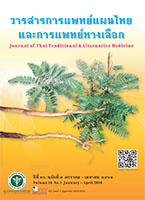Quantitative Analysis of Eurycomanone in Eurycoma longjifolia Jack (Root) by High Performance Liquid Chromatography (HPLC)
Main Article Content
Abstract
Eurycomanone is a quassinoid isolated from the roots of tongkat ali or pla-lai phueak (Eurycoma longjifolia Jack, Family Simaroubaceae). It has shown antipyretic, antimalarial, and aphrodisiac activities. Since there is no quality control of eurycomanone in tongkat ali root in Thailand, a HPLC method for determination of eurycomanone content has been developed and validated. Sample preparation was undertaken by refluxing 2 g of powdered drug in 50 ml of methanol for 1 hr, filtering and evaporating the extract until it was dry. The residue was redissolved and adjusted with 50% methanol to 10 ml. A 20-µl portion of sample solution was injected to HPLC system. The analysis was performed using Atlantis® T3, C18, 4.6 x 150 mm, 3-µm column; and solvent A, distilled water, and solvent B, a mixture of acetonitrile and methanol (1:1) were used as a mobile phase at a flow rate of 1.5 ml/min, and detected with PDA at wavelength 243 nm. Linearity was established for the eurycomanone concentration range of 0.06–0.36 mg/ml with a coefficient of determination (R2) 0.9995. The recovery rate was in the range of 96%–105%, while HORRAT was in the range of 1.66–1.96, and LOD and LOQ were 0.0106 µg/ml and 0.0354 µg/ml, respectively. It was shown that this developed method was suitable and could be used to analyze the content of eurycomanone in tongkat ali root and an appropriate specification of eurycomanone content in tongkat ali root could be established.
Article Details
References
2. Boonyaprapat N, Chokchaicharoenporn O. Medicinal plants indigenous to Thailand. Bangkok: Prachachon Co Ltd; 2000. p.175-6. (in Thai)
3. Supcharoen P, Rueng-rangsri N, Deewisej K. Herbal plants in national parks in central Thailand. 2nd ed. Nonthaburi: Thai Traditional Medicine Development Foundation; 2006. 108 p. (in Thai)
4. National List of Essential Medicines (No. 2) B.E. 2554 (2011). Published in Government Gazette on 28 June B.E. 2554 (2011). (in Thai)
5. Yusuf H, Mustofa M, Wijayanti A, Susidarti RA, Asih PBS, Suryawati, et al. A new quassinoid of four isolated compounds from extracts Eurycoma longifolia Jack roots and their in-vitro antimalarial activity. International Journal of Research in Pharmaceutical and Biomedical Sciences. 2013;4(3):728-34.
6. Ang HH, Hitosuyanagi Y, Fukaya H, Takeya K. Quassinoids from Eurycoma longifolia. Phytochemistry. 2002;59(8):833–7.
7. Kardono LB, Angerhofer CK, Tsauri S, Padmawinata K, Pezzuto JM, Kinghorn AD. Cytotoxic and antimalarial constituents of the root of Eurycoma longifolia. J Nat Prod. 1991;54(5):1360–7.
8. Low BS, Teh CH, Yuen KH, Chan KL. Physico–chemical effects of the major quassinoids in a standardized Eurycoma longifolia extract (Fr 2) on the bioavailability and pharmacokinetic properties, and their implications for oral antimalarial activity. Nat Prod Commun. 2011;6(3):337–41.
9. Hajjouli S, Chateauvieux S, Teiten MH, Orlikova B, Schumacher M, Dicato M, et. al. Eurycomanone and eurycomanol from Eurycoma longifolia Jack as regulators of signaling pathways involved in proliferation, cell death and inflammation. Molecules. 2014;19(9):14649–66.
10. Chan KL, Choo CY, Abdullah NR, Ismail Z. Antiplasmodial studies of Eurycoma longifolia Jack using the lactate dehydrogenase assay of Plasmodium falciparum. J Ethnopharmacol. 2004;92(2–3):223–7.
11. Low BS, Das PK, Chan KL. Standardized quassinoids-rich Eurycoma longifolia extract improved spermatogenesis and fertility in male rats via the hypothalamic–pituitary–gonadal axis. J Ethnopharmacol. 2013;145(3):706–14.
12. Purwantiningsih A, Ismail S, Hussin AH, and Chan KL. Inhibitory effect of Eurycoma longifolia extract and eurycomanone on human cytochrome P450 isoforms. International Journal of Pharmacy and Pharmaceutical Sciences. 2014;(6):441-5.
13. Pan Y, Tiong KH, Abd-Rashid BA, Ismail Z, Ismail R, Mak JW, et. al. Effect of eurycomanone on cytochrome P450 isoforms CYP1A2, CYP2A6, CYP2C8, CYP2C9, CYP2C19, CYP2E1 and CYP3A4 in vitro. J Nat Med. 2014;68(2):402–6.
14. Zaini NN, Osman R, Juahir H, Saim N. Development of chromatographic fingerprints of Eurycoma longifolia (Tongkat ali) roots using online solid phase extraction–liquid chromatography (SPE-LC). Molecules. 2016;21(5):1–10.
15. Norhidayah A, Vejayan J, Yusoff M. Detection and quantification of eurycomanone levels in tongkat ali herbal products. Journal of Applied Sciences. 2015;15(7):999-1005.
16. Khari N, Aisha AFA, Ismai Z. Reverse phase high performance liquid chromatography for the quantification of eurycomanone in Eurycoma longifolia Jack (Simaroubaceae) extracts and their commercial products. Tropical Journal of Pharmaceutical Research. 2014;13(5):801–7.
17. Ling SK, Salbiah M, Fauziah A, Mohamad LN. Study of Eurycoma longifolia by FT-IR and 2D–IR correlation spectroscopy. Forest Research Institute Malaysia. Proceedings of the Seminar on Medicinal and Aromatic Plants (MAPS2008). Malaysia: 2009. p. 258-67.
18. Department of Medical Sciences. Thai herbal compendium on physico-chemical specification volume I. Nonthaburi: Department of Medical Sciences; 2016. p. 17–9. (in Thai)
19. Department of Medical Sciences. A practical guide for single laboratory method validation of chemical methods. Nonthaburi: Department of Medical Sciences; 2006. (in Thai)
20. Department of Standards Malaysia. Phytopharmaceutical aspects of freeze dried water extract from tongkat ali roots – specification. Malaysia: Malaysian standard; 2011. 12 p.


